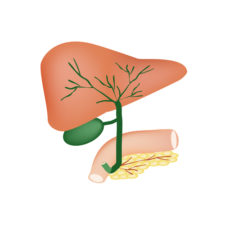 Gallbladder courtesy of Shutterstock
Gallbladder courtesy of Shutterstock
As you're probably aware, everything from obesity to baldness is being blamed on high consumption of sugar. Now there's a new ailment to add to the list — gallbladder cancer — at least according to a new study published in the Journal of the National Cancer Institute.
The gallbladder is a small sack (usually depicted as green) that's tucked away between lobes of the liver. Bile produced by the liver is collected and stored in the gallbladder. When a fat-containing food is consumed, the gallbladder contracts and sends the bile, through a series of ducts, into the small intestine where it helps digest fats so the body can absorb them. Gallbladder cancer can occur in the sack itself, in the collecting ducts in the liver, as well as in the ducts leading from the bladder to the small intestine (the "biliary tree" includes the whole set of ducts both within and outside the liver).
The current study, led by Dr. Susanna C. Larsson from the Karolinska Institute in Stockholm, Sweden, followed nearly 71,000 Swedish adults between 45 and 83 years old for an average of about 13 years. These adults were part of two large Swedish studies: the Swedish Mammography Cohort and the Cohort of Swedish Men.
Each participant completed a food-frequency questionnaire at their admission to the current study, which provided the information on sweetened beverage consumption— both those sweetened with sugar and those sweetened with low-or no-calorie sweeteners. The beverages the researchers tracked did not include fruit juices, energy and sports drinks, or sweetened coffee, tea or milk. They also quantified participants' total sucrose intake.
During the followup period, 219 biliary tract cancers occurred — 71 were in the gallbladder itself, 21 were in the ducts within the liver and the rest in the ducts outside the liver.
Examination of the data found a link between high consumption (more than two per day) of sweetened beverages and gallbladder cancer and extrahepatic biliary tree cancer: the risk was 2.24 for the former and 1.79 for the latter — both statistically significant. In addition, total sucrose intake was significantly associated with gallbladder cancer with a risk of 2.55 for the highest vs. the lowest intake levels.
In their discussion, the authors suggested that sweetened beverage consumption and sucrose consumption might increase gallbladder cancer risk either directly via blood levels of glucose and insulin, or indirectly by raising the risks of obesity, diabetes or gallstone disease.
As the authors noted, in this type of observational study, confounding factors cannot be ruled out. In addition, sucrose and beverage consumption was ascertained only at the beginning of the study, and one must assume that this stayed constant over the 13+ years of followup.
Further, self-reported food consumption is always heir to misreporting and errors in judgement on the part of participants. And the fact that sugar-sweetened and artificially sweetened beverages were lumped together could also introduce errors in classification of these items. But when the total sucrose consumption was calculated, all the sweetened beverages were assumed to be sweetened with sugar — obviously leading to an overestimation on sucrose consumption.
Again, as we have noted in the past when describing such studies, observational studies cannot be assumed to find a causal link between associated factors. More research is needed. For anyone concerned about this supposed link — moderation in consumption is always the first line of defense.



